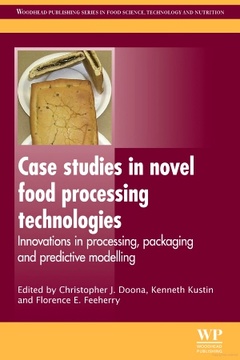Description
Case Studies in Novel Food Processing Technologies
Innovations in Processing, Packaging, and Predictive Modelling
Woodhead Publishing Series in Food Science, Technology and Nutrition Series
Coordinator: Doona C J
Language: English
Subjects for Case Studies in Novel Food Processing Technologies:
Publication date: 08-2016
Support: Print on demand
Support: Print on demand
Description
/li>Contents
/li>Biography
/li>Comment
/li>
Novel food processing technologies have significant potential to improve product quality and process efficiency. Commercialisation of new products and processes brings exciting opportunities and interesting challenges. Case studies in novel food processing technologies provides insightful, first-hand experiences of many pioneering experts involved in the development and commercialisation of foods produced by novel processing technologies.
Part one presents case studies of commercial products preserved with the leading nonthermal technologies of high pressure processing and pulsed electric field processing. Part two broadens the case histories to include alternative novel techniques, such as dense phase carbon dioxide, ozone, ultrasonics, cool plasma, and infrared technologies, which are applied in food preservation sectors ranging from fresh produce, to juices, to disinfestation. Part three covers novel food preservation techniques using natural antimicrobials, novel food packaging technologies, and oxygen depleted storage techniques. Part four contains case studies of innovations in retort technology, microwave heating, and predictive modelling that compare thermal versus non-thermal processes, and evaluate an accelerated 3-year challenge test.
With its team of distinguished editors and international contributors, Case studies in novel food processing technologies is an essential reference for professionals in industry, academia, and government involved in all aspects of research, development and commercialisation of novel food processing technologies.
Part one presents case studies of commercial products preserved with the leading nonthermal technologies of high pressure processing and pulsed electric field processing. Part two broadens the case histories to include alternative novel techniques, such as dense phase carbon dioxide, ozone, ultrasonics, cool plasma, and infrared technologies, which are applied in food preservation sectors ranging from fresh produce, to juices, to disinfestation. Part three covers novel food preservation techniques using natural antimicrobials, novel food packaging technologies, and oxygen depleted storage techniques. Part four contains case studies of innovations in retort technology, microwave heating, and predictive modelling that compare thermal versus non-thermal processes, and evaluate an accelerated 3-year challenge test.
With its team of distinguished editors and international contributors, Case studies in novel food processing technologies is an essential reference for professionals in industry, academia, and government involved in all aspects of research, development and commercialisation of novel food processing technologies.
Introduction to non-thermal food pasteurisation processes. Part 1 Case studies in HPP and PEF processing of food: Commercial HPP of ham at Esteban Espuña; HHP processing of fruit juices and smoothies; PEF systems for commercial food and juice processing; The environmental impact of PEF treatment and HPP. Part 2 Case studies in other novel food processing techniques: Industrial applications of high power ultrasonics; The potential of novel IR food processing technologies; Validation and commercialisation of dense phase carbon dioxide processing for orange juice; Progress and issues with the commercialisation of cool plasma; Commercial applications of ozone in food processing; Novel technologies for the decontamination of fruits and vegetables. Part 3 Case studies in food preservation using antimicrobials, novel packaging and storage techniques: Use of natamycin on baked goods; Commercial application of oxygen depleted atmospheres for food preservation; Commercialisation of TTIs for foods; Development of a nanocomposite meal bag for individual military rations. Part 4 Innovations in advanced food processing techniques and predictive microbial models: Case studies: Commercial developments in in-container retort technology; Industrial microwave heating of food: Principles and three case studies of commercialisation; Irradiation of fresh fruit and vegetables; Consumer acceptance and marketing of irradiated meat; Comparing the effectiveness of thermal and non-thermal food preservation processes; A case study in military ration foods: The Quasi-chemical model and a novel accelerated three-year challenge test.
Christopher Doona is a Senior Research Chemist at the US Army Natick Soldier RD&E Center, Warfighter Science, Technology & Applied Research Directorate, USA.
- Provides insightful, first-hand experiences of many pioneering experts involved in the development and commercialisation of foods produced by novel processing technologies
- Presents case studies of commercial products preserved with the leading nonthermal technologies of high pressure processing and pulsed electric field processing
- Features alternative novel techniques, such as dense phase carbon dioxide, ozone, ultrasonics, cool plasma, and infrared technologies utilised in food preservation sectors
© 2024 LAVOISIER S.A.S.
These books may interest you

Novel Food Fermentation Technologies 158.24 €

Novel Food Fermentation Technologies 158.24 €


